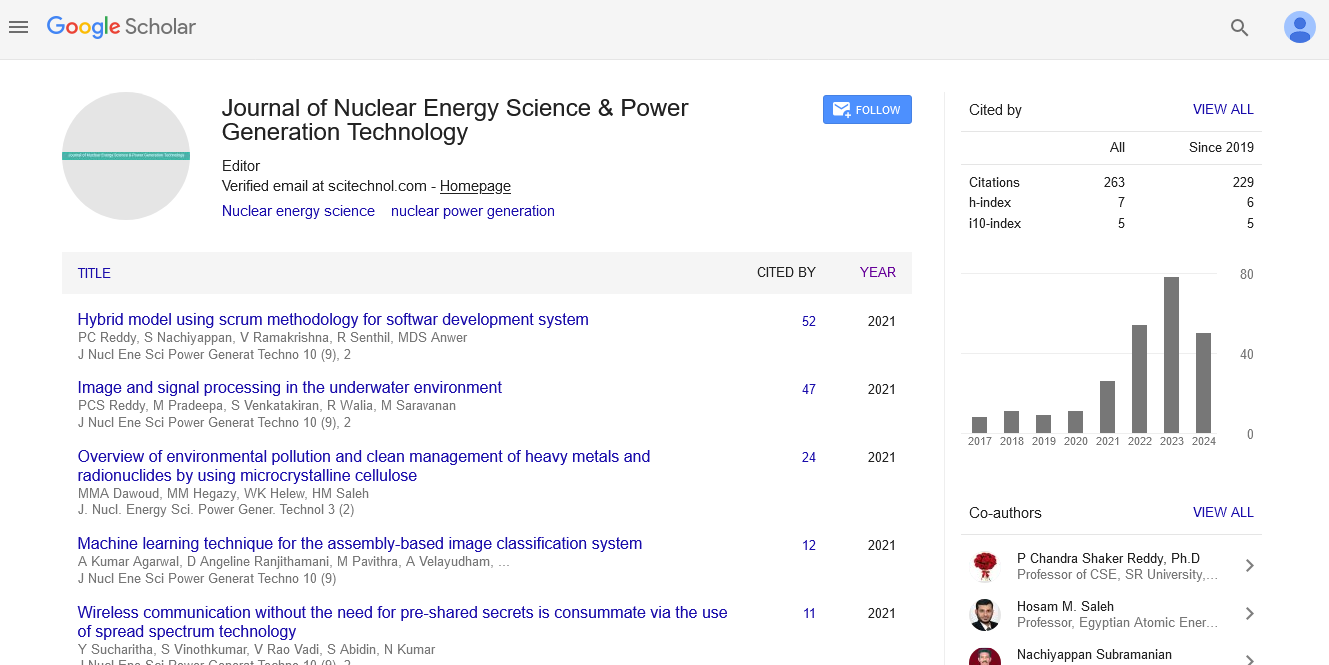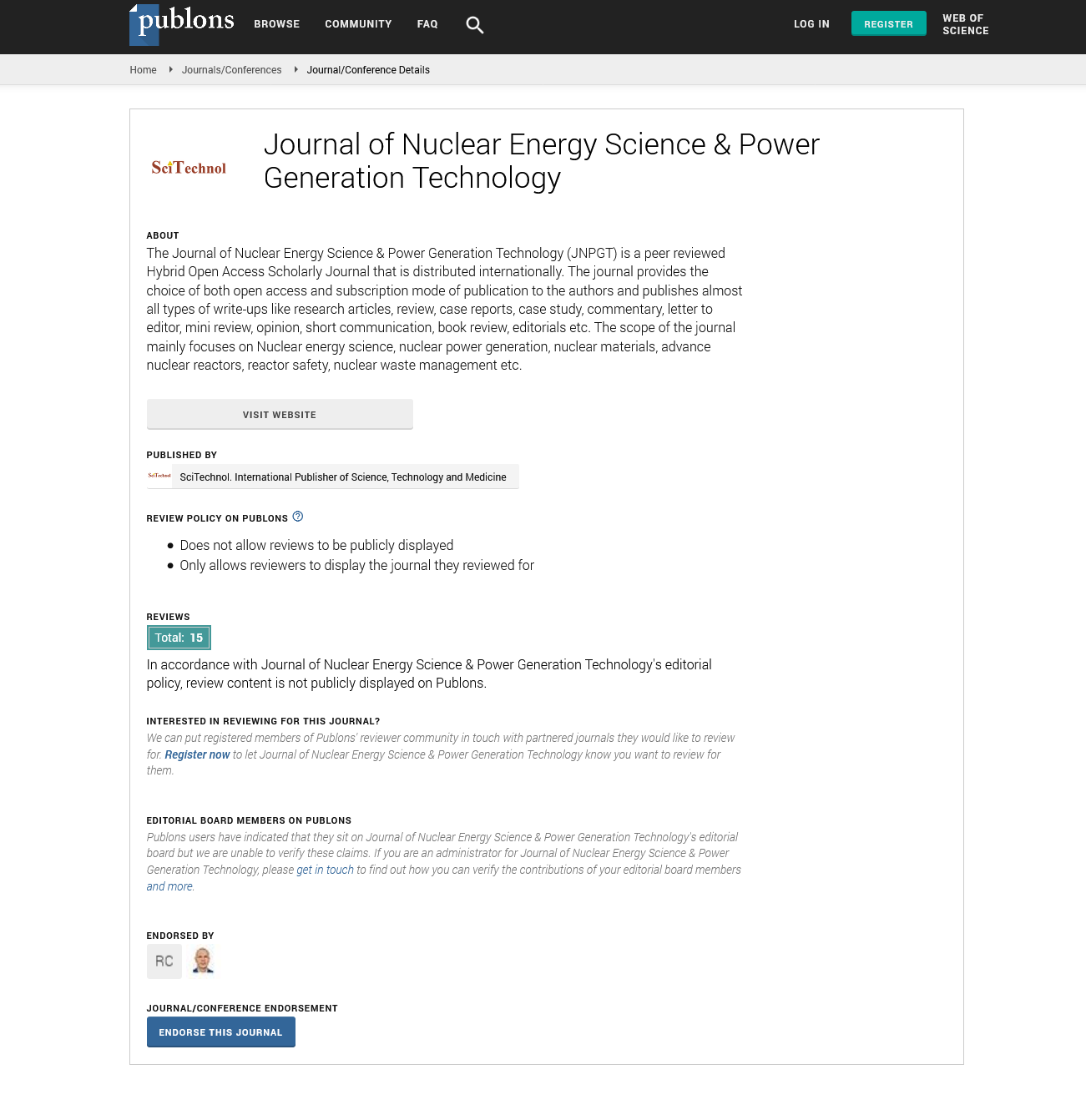Commentary, J Nucl Ene Sci Power Generat Technol Vol: 13 Issue: 6
Comparative Analysis of Thorium Fuel Cycles and their Use in Nuclear Reactors
Furisa Klen*
1Department of Radiation Safety and Nuclear Technology, University of Bucharest, Bucharest, Romania
*Corresponding Author: Furisa Klen,
Department of Radiation Safety and Nuclear
Technology, University of Bucharest, Bucharest, Romania
E-mail: furisa_16klen@gmail.com
Received date: 21 October, 2024, Manuscript No. JNPGT-24-154867;
Editor assigned date: 23 October, 2024, PreQC No. JNPGT-24-154867 (PQ);
Reviewed date: 06 November, 2024, QC No. JNPGT-24-154867;
Revised date: 13 November, 2024, Manuscript No. JNPGT-24-154867 (R);
Published date: 21 November, 2024, DOI: 10.4172/2325-9809.1000423.
Citation: Klen F (2024) Comparative Analysis of Thorium Fuel Cycles and their Use in Nuclear Reactors. J Nucl Ene Sci Power Generat Technol 13:6.
Description
As the demand for cleaner, more sustainable energy sources grows, nuclear power is increasingly seen as a vital component of the global energy mix. However, conventional nuclear power depends heavily on uranium, which comes with challenges such as limited availability, long-lived radioactive waste and proliferation risks. Thorium, an alternative nuclear fuel, has emerged as a promising solution, providing significant advantages over uranium in terms of efficiency, safety and sustainability. Thorium is a naturally occurring, slightly radioactive element found in abundance in the Earth’s crust. Unlike uranium, most thorium exists in a single isotope, Thorium-232, which is not directly capable but can be converted into capable Uranium-233 through a process called neutron absorption. This capability makes thorium a productive material meaning it can sustain a nuclear reaction when paired with an initial source of material, such as Uranium-235 or Plutonium-239.
Advantages of thorium based reactors
Thorium is three to four times more abundant than uranium and is widely distributed across the globe. Countries like India, USA and Australia have significant thorium reserve ensuring a long-term supply of fuel. Thorium reactors produce substantially less long-lived radioactive waste compared to uranium reactors. The waste generated from thorium fuel cycles has a shorter half-life, making storage and disposal more manageable. Thorium reactors are designed to operate at lower pressures, reducing the risk of catastrophic accidents. Additionally, their inherent design makes them less likely to experience meltdowns as they are often paired with molten salt or liquid-metal coolants that can passively remove heat. Unlike Uranium-235 or Plutonium-239, the byproducts of thorium fuel cycles are less suitable for weaponization. This makes thorium reactors an attractive option for countries concerned about nuclear security. Thorium fuel cycles can achieve higher burnup rates, meaning more energy is extracted from the fuel before it is considered waste. This improves the overall efficiency of nuclear energy production. Several reactor designs are being developed to connect the potential of thorium as a nuclear fuel. Molten Salt Reactors (MSRs) are a leading candidate for thorium utilization. In these reactors, thorium is dissolved in molten salt, which acts as both a fuel and a coolant. Molten Salt Reactors (MSRs) provide advantages such as high thermal efficiency, passive safety features and the ability to Canada Deuterium Uranium reactors recycle fuel. Canada’s CANDU reactors can be modified to use thorium fuel. These reactors use heavy water as a moderator, enabling efficient use of thorium without the need for enrichment. Accelerator- Driven Sub-Critical Reactor Systems (ADS) are experimental reactors that use a particle accelerator to initiate and sustain a nuclear reaction in thorium fuel. This design provides significant safety benefits, as the reaction stops if the accelerator is turned off.
Conclusion
Their modular design and high-temperature operation make them suitable for safe and efficient energy production. The infrastructure for thorium reactors is still under development, requiring significant investment in research and technology. Transitioning from uranium to thorium involves high initial costs for redesigning reactors and fuel cycles. Global regulatory frameworks are currently personalized to uranium reactors, requiring updates to accommodate thorium technologies. Despite these challenges, several countries are investing in thorium research with its abundant thorium reserves, is leading the way with plans for large-scale deployment of thorium reactors. Thorium-based reactors present a compelling alternative to traditional uranium-based nuclear power. With their abundance, reduced waste production, enhanced safety and proliferation resistance, thorium reactors could revolutionize the future of nuclear energy.
 Spanish
Spanish  Chinese
Chinese  Russian
Russian  German
German  French
French  Japanese
Japanese  Portuguese
Portuguese  Hindi
Hindi 

